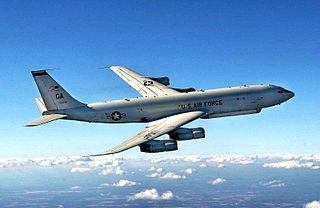
The 116th Air Control Wing is a Wing of the Georgia Air National Guard/United States Air Force, stationed at Robins Air Force Base, Georgia. If activated for federal service, the wing is gained by Air Combat Command.

The 35th Fighter Wing is an air combat unit of the United States Air Force and the host unit at Misawa Air Base, Japan. The wing is part of Pacific Air Forces (PACAF)'s Fifth Air Force.

The 103rd Airlift Wing is a unit of the Connecticut Air National Guard, stationed at Bradley Air National Guard Base at Bradley International Airport, Windsor Locks, Connecticut. If activated to federal service with the United States Air Force, the 103 AW is operationally-gained by the Air Mobility Command (AMC).

The 113th Wing, known as the "Capital Guardians", is a unit of the District of Columbia Air National Guard, stationed at Joint Base Andrews, Maryland. If activated to federal service, the fighter portion of the Wing is gained by the United States Air Force's Air Combat Command, while the airlift portion is gained by Air Mobility Command.

The 136th Airlift Wing is a unit of the Texas Air National Guard, stationed at Naval Air Station Joint Reserve Base Fort Worth, Fort Worth, Texas. If activated to federal service, the wing is gained by the United States Air Force's Air Mobility Command (AMC).
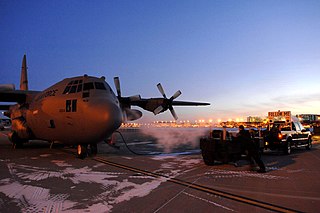
The 133rd Airlift Wing is a unit of the Minnesota Air National Guard, stationed at Minneapolis–Saint Paul Joint Air Reserve Station, Minnesota. If activated to federal service, the Wing is gained by the United States Air Force Air Mobility Command.
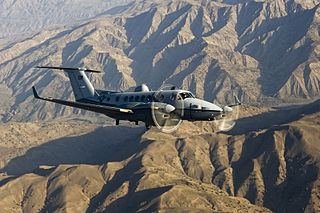
The 137th Special Operations Wing is a unit of the Oklahoma Air National Guard located at Will Rogers Air National Guard Base, Oklahoma. If activated to federal service, the wing is gained by Air Force Special Operations Command. During World War II, its predecessor, the 404th Fighter Group, flying Republic P-47 Thunderbolts, provided close air support to troops following the Operation Overlord, the Normandy landing until the close of the war. The wing is entitled to the honors won by the group by temporary bestowal.
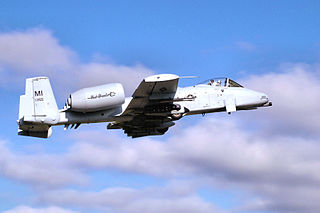
The 127th Operations Group is a unit of the Michigan Air National Guard. It is stationed at Selfridge Air National Guard Base and 1s one of two flying groups assigned to the 127th Wing. The group operates Fairchild Republic A-10 Thunderbolt II ground attack aircraft.

The 181st Airlift Squadron is a unit of the 136th Airlift Wing of the Texas Air National Guard stationed at Naval Air Station Joint Reserve Base Fort Worth, Texas. The 181st is equipped with the Lockheed C-130J Hercules.

The 142d Airlift Squadron is a unit of the Delaware Air National Guard 166th Airlift Wing located at New Castle Air National Guard Base, Delaware. It is equipped with the C-130H Hercules.

The 185th Special Operations Squadron is a unit of the Oklahoma Air National Guard's 137th Special Operations Wing, located at Will Rogers World Airport, Oklahoma City, Oklahoma. The 185th is the only National Guard unit to be equipped with the MC-12W. The unit is known as the "Sooners". Famous unit alumni include former Vietnam prisoner of war Brig. Gen. James Robinson "Robbie" Risner and Astronaut Captain Fred Wallace Haise Jr., Apollo 13 Lunar Module Pilot.

The 62d Fighter Squadron is part of the United States Air Force 56th Operations Group at Luke Air Force Base, Arizona. It operates the Lockheed Martin F-35A Lightning II aircraft conducting advanced fighter training.

The 179th Fighter Squadron is a unit of the Minnesota Air National Guard 148th Fighter Wing located at Duluth Air National Guard Base, Minnesota. The 179th is equipped with the General Dynamics F-16C Fighting Falcon.

The 193rd Special Operations Squadron is a unit of the Pennsylvania Air National Guard 193rd Special Operations Wing located at Harrisburg Air National Guard Base, Middletown, Pennsylvania, The 193rd is equipped with the EC-130J Commando Solo.

The 46th Fighter Training Squadron is an inactive United States Air Force unit. Its last assignment was with the 917th Operations Group at Barksdale Air Force Base, Louisiana. where it was inactivated on 1 October 1993.

The 568th Air Defense Group is a disbanded United States Air Force organization. Its last assignment was with Air Defense Command (ADC)'s 4709th Air Defense Wing at McGuire Air Force Base, New Jersey, where it was inactivated in 1954. The group was originally activated as the 568th Air Service Group, a support unit for a combat group at the end of World War II on Guam, but was soon inactivated.

Duluth Air National Guard Base is a United States Air National Guard base located on the grounds of Duluth International Airport. It is home to the 148th Fighter Wing.
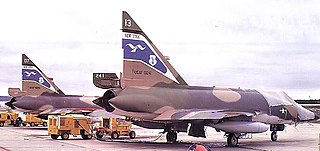
The 106th Fighter-Interceptor Wing is a former unit of the New York Air National Guard, last stationed at Francis S. Gabreski Air National Guard Base, Westhampton Beach, New York.

The 137th Special Operations Group is an associate unit of the Oklahoma Air National Guard stationed at Will Rogers Air National Guard Base. If activated for federal service, the group is gained by Air Force Special Operations Command.

The 127th Wing is a composite wing of the United States Air Force and Michigan National Guard. It is composed of approximately 1,700 Citizen-Airmen and provides highly trained personnel, aircraft, and support resources to serve the Michigan community, the state and the United States. The wing operates Boeing KC-135 Stratotankers, providing global aerial refueling capability in support of Air Mobility Command, and the Fairchild Republic A-10 Thunderbolt II, flying the close air support mission for Air Combat Command. The current commander of the 127th Wing is Brig. Gen. Rolf E. Mammen. With approximately 1,700 personnel assigned, the 127th Wing is among the most complex Air National Guard wings. The 127th Wing's home station, Selfridge Air National Guard Base, is the largest facility managed by a reserve component of the U.S. Air Force.
























